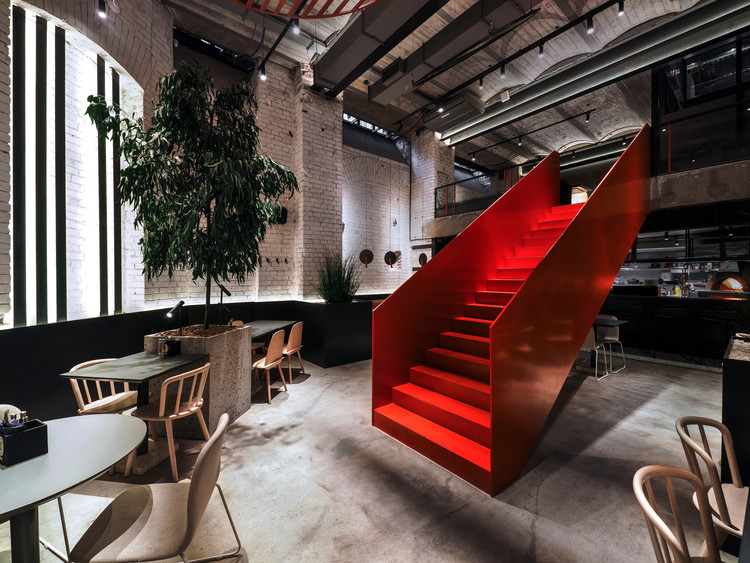Proyecto Roble Équipe Voor Architectuur En Urbanisme
2013-04-10 01:00
.class=‘class 1’>室内设计.=.多规格少规格
Interior Design Équipe voor architectuur en urbanisme Garden Design Studio Van Helvoirt Manufacturers Loading... More Specs Less Specs
青年办公室的“Proyecto Roble”是一个基层项目,是一座嵌入荷兰南部农村地区当地环境的建筑。这位客户是景观美化公司Van Helvoirt Groenprojecten的所有者,他希望总部成为可持续发展的旗舰模式。这是一个关键项目,在这个项目中,可持续的创新将资金问题作为底线。
“Proyecto Roble” by young office Équipe is a grass roots project, a building embedded in the local context in the rural south of the Netherlands. The client, owner of landscaping firm Van Helvoirt Groenprojecten, had a vision for his headquarters to be a flagship model of sustainability. This was to be a key project where sustainable innovations replace money-issues as the bottom line.
这座建筑是一个自定义设计的环境,没有标准的细节。该项目是为了研究创造积极工作场所的潜力而进行的。关键主题被细分为各个组成部分,并在设计中加以表达。“感觉很好!”它包含了不同的主题,如可再生能源、被动的气候控制、丰富的自然光以及与外部景观的关系,而外部景观是愈合环境花园的展示。
The building is a custom designed environment with no standard details. The project was undertaken as a research into the potentials for creating a positive workplace. Key themes were broken down into components and expressed in the design. “Feel Good!” was the catchphrase coined that encompassed the different themes as renewable energy, passive climate control, abundance of natural light and the relationship to the external landscape, which was to be a showpiece of healing environment garden.
因此,可持续性在所有阶段和所有规模都得到了重视。从研究“可持续性”实际上意味着什么到确保建筑工地上的每个人都理解和接受这些原则。采用了一种新的招标方式,称为“建筑团队+”,并发明了一种新的公式来记录关于重要性和技术的决定。
Sustainability was thus been payed attention to in all stages and all scales. From a period of studying what ‘sustainability’ actually means to making sure everyone on the building site understands and embraces these principals. A.o. a new way of tendering was used, called the Building-team Plus and a new formula was invented to document decisions on materiality and techniques.
新的延伸立刻吸引了路过的汽车司机的注意,一个光滑的红色形式在土地景观中,充满了一个完全集成的光伏面板屋顶和绿色屋顶。绿色屋顶超越了它的化妆作用,是新兴的水过滤技术的试验场。20世纪初,蒂尔堡以其纺织业而闻名,工人们把它作为漂白剂用在水罐里。现在这个项目回到了这个传统,发明了世界上第一个倾斜的人工湿地。
The new extension immediately catches the passing motorist’s eye, a sleek red form in the agrarian landscape, replete with a fully integrated photo-voltaic-panel roof and a green roof. The green roof transcends its cosmetic role, and is a testing ground for emerging water filtration technology. In the beginning of the 20th century Tilburg was re-known for its textile industry, collecting the workers pee in pitchers for using it as a bleach. Now this project goes back to this tradition inventing worlds first sloped constructed wetlands.
尿液是从黑水中分离出来的,使用它作为一种营养成分,在客户的环境美化活动中制造肥料。此外,灰色的水流过草屋顶,留下干净的水,可以再次在建筑物中使用。这只是这个项目中设计到最小细节的多项创新之一:从建筑到花园,从自行车棚到定制内部和路标。
Urine is separated from the black water using it a as a nutrition ingredient for making fertiliser in the clients landscaping activities. Further the grey water runs through the grass roof leaving it as clean water that can be used in the building again. This is only one of the multiple innovations in this project that has been designed to the smallest detail: from building to garden, from the bicycle shed to the bespoke interior and signposting.
这座建筑由两个部分组成,由粘土炉子连接。这一元素被绿色植物本身的生意浪费掉,把办公室的员工和户外的工人聚集在一起。从而将新的延伸与家族企业的传统联系起来。在室内气氛宜人的同时,粘土炉也带来了技术优势。空气采暖泵具有容量小的特点,并可作为热水锅炉使用。
The building consists of two parts, connected by the clay stove. Heated with prune wasted from the greenery’s own business, this element brings together the office-employees and the outdoor workers. Thus connecting the new extension to the traditions of the family business. Besides the pleasant indoor atmosphere the clay stove also brings technical advantages. The air heating pump could have less capacity and in addition the heater is used as a hot water boiler.
大楼的北部由办公室组成。建筑物的线性是由放置在彩色通道上的内部元素来强调的。通过在地板和家具的不同区域使用红色油毡,室内保持与建筑外观的一致性。
The north part of the building consists of offices. The linearity of the building is emphasised by the interior elements, that are placed on the coloured pathways. By using red linoleum on different areas of the floor and furniture the interior keeps a coherency to the exterior looks of the building.
这栋建筑的南部是一个超大的门厅,连接着所有的空间。这个多用途的大厅,用于更大、更小、有组织和自发的会议,提供了一个绿色和透明的连接到户外世界。折叠式铝制照明托盘使线条的发挥具有表现力,使之浮在建筑物的长度上。
The southern part of the building is a oversized foyer that connects all spaces. This multipurpose lobby, used for bigger and smaller, organised and spontaneous meetings, provides a green and transparent link to the outdoor world. The play of lines has been made expressive by folded raw aluminium lighting trays that float the length of the building.
正面是开放的,详细的,木制石板漆成红色,以水为基础的‘自然油漆’,从而创造了不同的透明度之间的内外。预制交叉层合木构件的结构未完成,木材的不完善增加了室内的自然宁静。木材充满了内部空间与自然的积极联系,这有助于美化公司的绿色形象。所有内部元素,除了二手椅子和台灯,都是定制设计的.它们是在与人员协商的情况下专门设计的。椅子和台车是二手的,就像室内设计中的各种较小的部件一样:员工入口处的门把手(重复使用的栏杆)、杂志架(加热管)和样品柜中的水果盒。在家具中也使用了低环境影响的产品。进行了专门研究,以调查哪些材料可以最好地用于哪些元素,以及如何将这些材料连接起来。就像外部一样,“决策文档”被用来探索构建团队中的考虑因素,以及能够记录结论。事实证明,这是一个非常有用的工具,可以帮助做出超出标准或规范的选择。根据分数,有意识地选择占优势。(尽管如此,所有计算出来的分数都很好)。被被动的房屋理论和荷兰能源性能规范可能导致小窗户在北面,这座建筑有很高的窗户从地板到天花板,为员工提供了景观和大量的北极光。
The facades are made of open detailed, wooden slats painted red with water based ‘nature paint’ thus creating different transparencies between inside and outside. The structure of prefabricated cross laminated timber elements is left unfinished, the imperfections of the timber adding to the natural serenity of the interior. The timber imbues the internal spaces with a positive connection to nature, something which contributes to the landscaping firms green image. All interior elements, apart from second-hand chairs and desk LED lamps, were custom designed. They are specifically designed in consultation with the personnel. Chairs and table carriages are second hand, like all kinds of smaller parts in the interior design: the door handle of the employees entrance (a re-used banister), the magazine stand (heating pipe) and the fruit boxes in the sample cabinet. Also in the furniture low environmental impact products were used. Special research was done to investigate what material could be best used in what elements and how should these materials be connected. Just like for the exterior the ‘decision document’ was used to explore the considerations in the building team plus and to be able to document conclusions. This proved to be a very useful tool that helps making choices that exceed standards or norms. During the whole process norms were never leading anyhow. Choosing consciously prevailed following scores. (Nevertheless all calculated scores are excellent) F.e. were passive house theories and Dutch energy performance norms may lead to small windows in the north facade, this building has high windows from floor to ceiling that provide the employees with a view to the landscape and lots of northern light.
Architects Équipe Voor Architectuur En Urbanisme
Location Tilburg the Netherlands
Architect in Charge Huib van Zeijl, Daniëlle Segers
Photographs René de Wit I Équipe
 举报
举报
别默默的看了,快登录帮我评论一下吧!:)
注册
登录
更多评论
相关文章
-

描边风设计中,最容易犯的8种问题分析
2018年走过了四分之一,LOGO设计趋势也清晰了LOGO设计
-

描边风设计中,最容易犯的8种问题分析
2018年走过了四分之一,LOGO设计趋势也清晰了LOGO设计
-

描边风设计中,最容易犯的8种问题分析
2018年走过了四分之一,LOGO设计趋势也清晰了LOGO设计


























































































